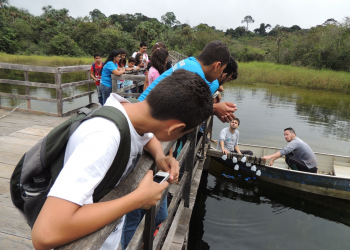English version at the end
Quando recebi uma proposta para escrever para o blog me veio à cabeça várias coisas interessantes que eu gostaria de falar. Claro que a primeira delas foi contar um pouco sobre o meu doutorado. Como o assunto central da minha tese é mudanças climáticas, eu poderia evidenciar como a diminuição de chuvas pode comprometer a biodiversidade de uma lagoa rasa amazônica e o reflexo disso nas relações tróficas. Certamente mostraria o desenho experimental e explicaria como montamos as estruturas que simularam as “mini-lagoas” para testar as minhas hipóteses. Além disso, poderia também expressar o quanto estou esperançoso por bons resultados, mas preferi deixar tudo isso para um outro momento. Decidi então falar sobre o que me proporcionou essa oportunidade de realizar um experimento durante cinco meses nesse cantinho maravilhoso do país.
Tive a imensa oportunidade de conhecer um município paraense muito especial, Parauapebas, localizado na região sudeste do Pará, próximo à Marabá, Curionópolis e Canaã dos Carajás. Aqui em Parauapebas, mais precisamente na Serra de Carajás, encontra-se uma das maiores concentrações de minério de ferro do mundo. A empresa VALE possui a concessão para extrair esse ferro e outros minérios na Serra dos Carajás, atraindo pessoas de diversas regiões do Brasil. Isto torna a população de Parauapebas muito miscigenada, com mineiros, piauienses, goianos, capixabas e, principalmente maranhenses, que chegam à região através de uma ferrovia que liga os dois estados desde que a mineração foi implantada.
Apesar deste município possuir muita influência de outras regiões do país, me surpreendi com o pouco da cultura regional ao qual eu tive acesso. Reparei que o paraense é apaixonado pelo Pará. Isso fica muito bem expresso nas letras das músicas do Carimbó, um estilo musical que pode ser dançado em roda ou dois a dois. Durante a dança as mulheres usam saia rodada com muitas cores que gira ao vento, seguindo o movimento da dança. Algumas delas dançam exibindo cestas e peneiras, que são utensílios utilizados principalmente na colheita da mandioca e para preparar os subprodutos da mesma. O cavalheiro, na dança, tem o papel de exaltar ainda mais a figura da mulher paraense.

Não tem como falar de Carimbó sem falar de Pinduca, o rei do Carimbó, que nos apresentou a garota do tacacá. Muito menos de Dona Onete que, com a sua simpatia e alegria, nos arrebata para o meio do Pitiú da feira do Ver-o-Peso. E se você acha pouco, ainda tem o “carimbó que segue a ginga do (…) rodado” de Lia Sophia! Algo que é muito nítido nas letras do carimbó é que elas estão muito voltadas para a realidade do povo paraense, contando histórias engraçadas evidenciando um povo alegre e divertido, além de exaltar a culinária.
À esquerda, Pinduca, o rei do carimbó e à direita, Dona Onete. Dois grandes cantores de carimbó.
E por falar em culinária…encontrei aqui uma infinidade de pratos típicos, sabores e misturas que jamais alguém pensaria que poderia dar certo. Vou começar pelo açaí. Se você está pensando naquele sorvete, extremamente doce, onde você coloca chantilly, paçoca, jujuba, granulado de chocolate etc, você está enganado. Isso não é açaí! Paraense toma açaí fresco, e quanto mais fresco estiver, melhor. Geralmente colocam uma colher de açúcar para deixar levemente adocicado. Alguns misturam com granola, farinha de mandioca ou tapioca em flocos. Pode ser tomado sozinho, mas quando está acompanhado com peixe o que era bom fica muito melhor!

É impossível falar de Pará e não falar da castanha-do-pará. As castanheiras são árvores de grande porte, com cerca de 50 metros de altura. As castanhas ficam dentro de um fruto que se assemelha a um côco, chamado popularmente de ouriço. Com um alto teor de gorduras e proteínas, as castanhas são grandes fontes de vitaminas e sais minerais. Muitas famílias vivem da coleta de castanhas fazendo desta atividade uma das suas principais fontes de renda. Porém, na Serra de Carajás os únicos que podem coletar esta semente são os índios da etnia Xikrin.
A mandioca (Manihot esculenta) é um dos grandes tesouros da terra. Da mandioca é extraída a farinha, a tapioca, o tucupi (líquido que escorre da mandioca ralada ao ser prensada) e até mesmo as folhas da mandioca são utilizadas. Todos esses subprodutos da mandioca estão presentes em diversos pratos. O Tacacá, por exemplo, é feito com o caldo do tucupi, camarão seco e jambú (Acmella oleracea), uma erva típica da região norte que tem como característica principal adormecer a boca, dando um paladar diferenciado à comida. A Maniçoba, outro prato regional, é conhecida como a feijoada paraense, mas ao contrário do que você possa imaginar, nessa feijoada não tem feijão. Nela o feijão é substituído pelas folhas da mandioca trituradas e cozidas por 7 dias para retirar o ácido cianídrico (uma substância altamente tóxica) e, então é misturada com carnes bovinas e suínas. Essas são poucas das iguarias do Pará, mas ainda há outras, como o pato no Tucupi, o arroz paraense, o vatapá etc.


Apesar de Parauapebas ser muito diferente de outros locais onde a cultura paraense é mais forte, fiquei muito feliz e impactado por conhecer uma pequena parte desse maravilhoso Estado. Todas essas delícias regionais, toda a alegria do povo, todo o charme da dança e a criatividade das letras das músicas mostram o quanto o Pará é rico, belo e acolhedor.
Como diz uma das letras de Pinduca: “Chegou no Pará, parou! Tomou açaí, ficou! ”. Pará é isso! Não é apenas um lugar de passagem, é um lugar de apreciação. Não é somente um “ficar” para comer o açaí. Porém é parar, apreciar, compreender e, somente então, “ficar” por tudo o que torna o esse lugar único. Um lugar onde a riqueza não está somente nos minérios, mas também na biodiversidade, na cultura e principalmente em um povo que tem muito orgulho de dizer: Ééééégua!
Talking about my PhD, let’s dance Carimbó?
When I was invited to write to the blog, I thought in many interesting things to talk about. Of course, I could to write about my PhD – climate change is the main topic of it. Therefore, I would love to talk about how I expect that decreases in rainfall could affect the biodiversity of an Amazonian shallow lagoon, and the trophic relationships therein. I would also certainly describe the experimental design and explain how we assembled the structures that simulated the “mini-ponds” to test my hypotheses, as well as my hopeful desire for good results. Instead, I preferred to leave all this for another moment, and rather to talk about what gave me this opportunity and allowed me to live for five months in this wonderful part of our country.
I had a great opportunity to meet a very special municipality, called Parauapebas, located in the southeast region of Pará State, near Marabá, Curionópolis and Canaã dos Carajás. Here in Parauapebas, more precisely in the Serra de Carajás, lies one of the highest concentrations of iron in the world, with the company VALE having the concession to extract this and other minerals from the place, which attracts people from several regions of Brazil. This makes the population of Parauapebas very well-mixed, with people from other States, such as Minas Gerais, Pauí, Goiás, Espírito Santo and, mainly, Maranhão, where people leave their State through a railroad that connects the two states ever since the mining was implanted.
Although this municipality is very influenced from other regions of the country, I was surprised by the regional culture presented to me. I realized that the people of Pará loves Pará so much! The lyrics of the songs of Carimbó express this very well – Carimbó is a musical style that can be danced as a group or in pairs. During the dance, women wear long colorful skirts that turn in the wind, following the movements of the dance. Some of them dance displaying baskets and sieves, which are utensils used in the manioc harvesting and used to prepare their byproducts. Men, in the dance, exalt even more the figure of the paraense woman.
There is no way to speak of Carimbó without mentioning Pinduca, the king of Carimbó, who introduced us to the “Tacacá’s Girl”. Much less than Dona Onete who, with her sympathy and joy, snatches us into the Pitiú of the Ver-o-Peso fair. In addition, there is still the “carimbó that follows the ginga of (…) round skirt” of Lia Sophia! Something that is very clear in Carimbó is that the lyrics focus of in the reality of Paraense people, telling funny stories about a joyful and fun people. Another interesting thing is that the lyrics exalt their cuisine too much.
Talking about cuisine …I found here an infinity of typical dishes, tastes and mixtures that no one would ever think could work. I will start with açaí. If you are thinking about that extremely sweet ice cream, where you fill up with chantilly, paçoca, jujube, chocolate granules etc, you are very mistaken. This is not açaí! Paraense appreciates fresh açaí, and the fresher it is better. They usually put a spoon full of sugar to make it slightly sweet. Some pleople mix açaí with granola, manioc flour or tapioca in flakes. You can eaten açaí without any side dish or accompanied with others dishes. Açaí with fish is even better!
It is impossible to talk about Pará and not talk about Brazilian nuts. The Pará nuts come very high trees, about 50 meters. The nuts are inside a fruit that looks like a coconut, popularly called an urchin. With a high content of fats and proteins, nuts are great sources of vitamins and minerals. Many families survive from the collection of nuts making this activity one of their main sources of income. However, in the Serra de Carajás, the only people who can collect the Brazil nut are the Indians of the Xikrin ethnic group.
Manioc (Manihot esculenta) is one of the great treasures of the earth. From the manioc is extracted the flour, the tapioca, the tucupi (liquid that flows from the grated manioc when it is pressed). Even the manioc leaves are used. All these manioc byproducts are present in several dishes. For example, Tacacá is prepared with the tucupi, dry shrimp and jambú (Acmella oleracea), a typical herb of the northern region whose main characteristic is to numb the mouth, giving a different taste to food. Maniçoba is another regional dish, called by paraense people bean stew. However, contrary to what you can imagine, this bean stew has no beans. These are replaced by the manioc leaves crushed and cooked for 7 days to remove the hydrocyanic acid (a highly toxic substance) and then mixed with beef and pork. These are few of the delicacies of Pará, but there are still others, like the duck in the Tucupi, the paraense rice, vatapá etc.
Although Parauapebas is very different from other counties where Pará’s culture is stronger, I am very happy and impressed by knowing this small part of this wonderful State. All these regional delights, all the people’s joy, all the charm of the dance and the creativity of the lyrics of the songs show how much Pará is rich, beautiful and welcoming.
Pinduca says: “You have arrived in Pará, so stop! You have eaten açaí, you stayed! “. Pará is it! It is not just a pass by place; it is a place of appreciation. It is not a “stay” only for the açaí, but it is stopping to appreciate, to understand and only then to “stay” for everything that makes this place unique. A place where wealth is not only in minerals, but also in biodiversity, culture and especially in a people that are very proud to say: Ééééégua!







![[Mês da Educação] Um educador que inspira outros educadores](https://limnonews.biologia.ufrj.br/wp-content/uploads/2020/10/img_0140-1-350x250.jpg)

Ei Joseph, que bom que você já havia lido o post do Leandro e no Pará só tomou açaí! Mas… explica o Ééééégua!, antes que cause mal entendidos! Belo e envolvente texto, e como a Clarice colocou em post que fez, quem constrói narrativas é mais citado!